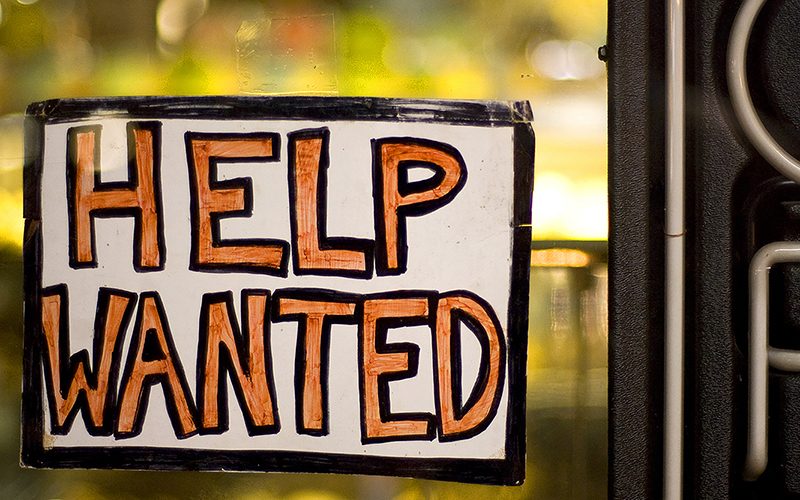
After one of the longest recoveries on record, unemployment in the state has fallen to the lowest level since 2007, at what experts hope is a more sustainable pace. (Photo by Matt Wetzler/Creative Commons)
WASHINGTON – Unemployment rates in Arizona inched down to 4.5 percent in October, falling to the lowest rate since the start of the Great Recession and capping one of the longest recoveries on record in the state.
Some experts said there may yet be improvements in the overall jobless rate, but all agreed that employment in the construction industry may not reach pre-recession levels.
But the highs of the “unsustainable” construction industry before the recession were partly to blame for the depths and length of the recession in the state, they say, so not going back there may not be as bad as it sounds.
“What we saw before the recession was unsustainable growth … focused in a few industries,” said Doug Walls, research administrator with the Arizona Office of Economic Opportunity. “Now, growth of the majority of the industries is even, including cornerstones of Arizona’s economy such as construction, and that was what took the hardest hit during the recession.”
Recession reflections:
See related stories looking back at Arizona 10 years after the start of the Great Recession:
The construction sector was indeed hard hit, falling from more than 210,000 workers at the start of the recession in 2007 to 111,000 in its depths, when the unemployment rate in the state peaked at 11.2 percent.
Construction employment has since bounced back – sort of – to 138,000 jobs in Arizona this year, according to the federal Bureau of Economic Analysis.
Walls said that “sort of” recovery in construction jobs shows that the imbalance that dug Arizona deeper into the recession – an imbalance he said could have come from an abnormally long economic expansion period before the recession – may have been corrected.
“The original problem was with construction, and run-away growth,” Walls said.
Elliott Pollack, an Arizona-based economist who focuses on real estate, echoed that, saying that “normally what causes a recession is that there are imbalances in an economy.”
“And a recession, and expansionary period allow for the correction of those imbalances,” Pollack said. “In the Great Recession of 2007 it was the financing of housing – people got over-extended with their loans.”
Walls said the recovery was one of the longest in Arizona’s history – more than four times longer than the previous recession. He said it took the state around four months and nine months, respectively, to recover from the previous two recessions, but “the 2007 one took around 35 months.”
“Arizona fell much farther and for a longer period of time than the U.S. because of the inflated construction costs across the nation,” Walls said. “I would say it lasted around 10 months longer (than the nation), and we lost a significant amount more jobs.
“Because of that, we had a longer way to come back to the level prior to the recession,” Walls said. “For the majority of the recovery we were worse off – hovering above the rest of the nation when it comes to unemployment numbers.”
But Pollack went further, saying Arizona has been “dead last in recovery.”
“There has been slow growth nationally but it was even slower in Arizona,” Pollack said.
Despite the return to a relatively normal labor market, Arizona’s economy is vastly different compared to 2007.
“We are still below our potential gross domestic product,” Pollack said. “This time it took eight years, normally it takes two – while it is on a cycle we had extremely slow growth.”
Pollack said the changes started as early as 2007.
“In 2006, everything was wonderful, but by 2007 the problem had already begun to manifest itself,” he said. “Population growth is slower than in the past. People aren’t moving like they did in the past, and millennials are taking longer to enter into the economic system.”
He also said that recovery in the labor market has been uneven across the state, with areas around Phoenix doing relatively well while others parts of the state, including Tucson, have lagged.
Heidi Shierholz, senior economist with the Economic Policy Institute, said that to properly analyze the recovery, you have to look “at the whole basket” – a combination of the employment rate and the unemployment rate. Comparing those numbers from before the recession and now, Shierholz said “they are pretty similar.”
“It is a little bit lower – but we have to look and see that the labor force participation rate is a little lower as well,” Shierholz said. “I would say if you look at the whole basket we are not quite back to the numbers that we saw before the Great Recession.”
But Shierholz said the return to market stability was a sign that the economy was not only as healthy as the beginning of the recession but that it was on a trajectory to go beyond pre-recession unemployment numbers.
“In the late ’90s, we had (unemployment rates in the) high 3s,” Shierholz said. “There is clear historic precedent for us returning to those low numbers – we may not continue to see the unemployment numbers falling at the same pace, but everything shows a continued downward trend for unemployment nationwide.”
Walls said that while no one can “really predict the shock of the market” that causes a recession, that “there is no coming recession on the horizon” based on all the current signs.